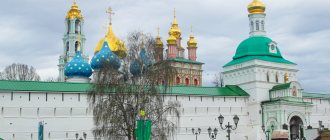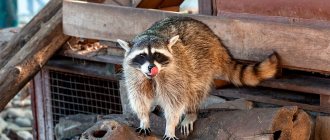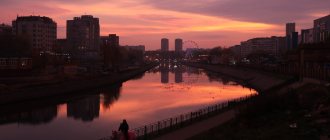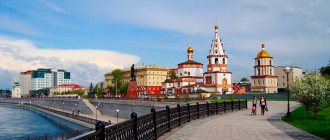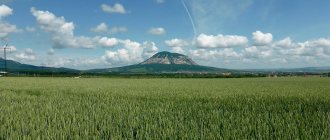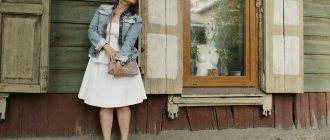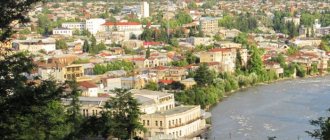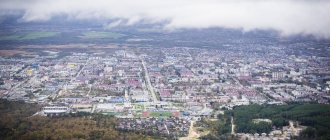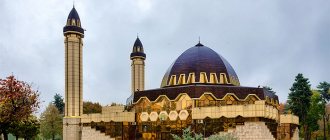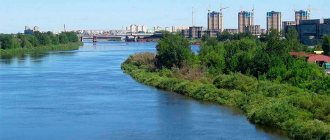Sergiev Posad stands out among the main attractions of the Moscow region, and indeed the whole country. This is much more than a beautiful old policy - one of the stars on the tourist map of the Russian Federation. Here a special form of spirituality arose, based on sincere faith in God, strict adherence to the commandments of the Lord, readiness for self-sacrifice for the good of the Fatherland, which has now become a generally recognized identifier of the Russian people. The forerunner of the modern city was the settlement formed around the monastery monastery founded by Sergius of Radonezh. Under Ivan the Terrible, the monastery, surrounded by brick walls with powerful towers, turned into an impregnable citadel. The fortress withstood a 16-month Polish siege during the Time of Troubles, and 79 years later it became a reliable shelter for the young prince from the Romanov dynasty, the future first Russian emperor. Subsequently, Sergiev Posad, which received city status in 1782, was repeatedly visited by august persons. Great thinkers of the past, famous writers came here - from the classics of Russian literature L. Tolstoy, M. Lermontov, N. Gogol, to A. Dumas the Father and L. Carroll. During the Soviet era, the polis, which bore the name Zagorsk from 1930 to 1991, became a significant part of the industrial cluster near Moscow. However, for hundreds of thousands of travelers it continues to be, first and foremost, a tourist Mecca.
The best attractions in the vicinity of Sergiev Posad
Gremyachiy Key waterfall
Gremyachiy Key waterfall
It is located 20 km from the city, near the village of Vzglyadnevo. The source is considered healing, which arose at the request of St. Sergius. It consists of several springs flowing from a height of 20 meters.
The area near the waterfall is well equipped: neat paths, a wooden refectory and a chapel, a font.
Address: Gremyachiy Klyuch waterfall, Vzglyadnevo village, Moscow region, Russia
Official website: https://www.gremyachiy.ru/
Ethnopark "Nomad"
Ethnopark "Nomad"
The park is dedicated to the life and activities of nomadic peoples, both Central Asian and Northern Russian regions. Here you can see the dwellings of the Mongols, Kalmyks, Nenets, and Yakuts.
The zoo yard, where camels, yaks, and sled dogs live, is extremely popular. Children can ride a reindeer or a dog sled.
Address: Ethnopark “Nomad”, Sergiev Posad district, Moscow region, Russia
Opening hours: daily from 11:00 to 19:00; Monday, Tuesday - closed
Entrance: for adults - 500 rubles, for children - 350 rubles, children under 7 years old - free
Official website: https://ethno-park.ru/
Estate "Muranovo" named after F. I. Tyutchev
Estate "Muranovo" named after F. I. Tyutchev
Founded in 1919 as a museum of everyday life of the 19th century, and later it became a museum of the poets Tyutchev and Baratynsky.
The museum is interesting as an example of a classic noble estate. In the main house you can see furniture from the second half of the 19th century, an office with personal belongings of poets, and many household items of that era - chandeliers, candelabra, clocks.
Address: Muranovo, Moscow region, Russia
Opening hours: daily from 10:00 to 18:00; Monday - closed
Entrance: for adults - from 50 rubles, for children - 30 rubles.
Official website: https://muranovo-museum.ru/ru/
Abramtsevo Museum-Reserve
Abramtsevo Museum-Reserve
An estate-estate, in which the owner was the writer Aksakov, and after him the entrepreneur Savva Morozov. Under Aksakov, Russian writers (Gogol, Turgenev) visited the estate. The next owner of Mamontov created the Mamontov art circle here, which included all the significant artists of that time (Serov, Vasnetsov, Nesterov, Polenov and others).
Interesting exhibitions in the Main Estate tell about the Aksakov family and the Mamontov circle.
Address: Muzeynaya street, 1, Khotkovo, Moscow region, Russia
Opening hours: daily from 10:00 to 18:00; Monday, Tuesday - closed
Entrance: for adults - 300 rubles, for children - 150 rubles, children under 6 years old - free
Official website: https://www.abramtsevo.net/
Spaso-Vifansky Monastery
Spaso-Vifansky Monastery
Buildings from the 18th and 19th centuries and modern structures that carefully recreate ancient buildings. The monastery flourished in the 19th century, at the beginning of the 20th century it was a rich monastery with its own factory and apartment buildings.
In 1917, the monastery was abolished, some of the buildings were used, and some were destroyed. In 1998, the monastery started working again.
Address: Maslieva street, 25, Ptitsegradsky village, Sergiev Posad, Moscow region, Russia
Opening hours: daily from 5:00 to 17:00
Official website: https://vifanskymonastir.cerkov.ru/
Chernigov monastery
Chernigov monastery
Creation time: 19th century. Located approximately 3 km from the city. The complex consists of a cave temple, Chernigov church and a bell tower.
The buildings are built in pseudo-Russian style and are very beautiful. The bell tower especially attracts attention - it is five-tiered, towering above the rest of the houses, of a deep scarlet color, it can be seen from afar.
Address: Gethsemane Ponds street, 1, Ferma village, Sergiev Posad, Moscow region, Russia
Opening hours: daily from 5:00 to 17:00; - day off
Official website: https://skit-chernigovsky.ru/
Desert of the Holy Paraclete
Desert of the Holy Paraclete
Created in 1858, the territory remote from the city was not chosen by chance - the inhabitants of the desert were going to lead a silent life. The desert was practically destroyed in the 30s, but was restored again 60 years later.
All that remains of the old complex are the buildings of the Temple of the Comforter Spirit (mid-19th century) and the gate bell tower from the early 20th century.
Address: Smena village, Sergiev Posad, Moscow region, Russia
Opening hours: daily from 7:00 to 17:00
Official website: https://paraklitova-pustyn.ru/
Pokrovsky Khotkov Monastery
Pokrovsky Khotkov Monastery
In the town of Khotkovo, 10–15 km from Posad, there is the Intercession Convent. The first mention of the monastery dates back to 1308, but no buildings from that time have survived.
The current complex of buildings was built in the 19th century - Intercession Cathedral, bell tower, monastic cells. There is a lot of greenery and flowers here. Walking along Pokrovsky is a pleasure.
Address: Kooperativnaya street, possession 2, Khotkovo city, Russia
Opening hours: daily from 6:00 to 21:00
"Bells of Rus'"
Address : Grigorovo village, Vladimir region; 25 km from Sergiev Posad along the A108 highway.
The exhibition of bells consists of several expositions. The history of the bell as a musical instrument is told here step by step and in detail. The first section is devoted to the beat, the second - to the bells. Bells of different shapes, wooden, stone, tin, were collected. Flat bells are also exhibited here. During the excursion you can feel the effect of sound waves using the bilotherapy method. Bilotherapy was officially recognized no more than 10 years ago. At the exhibition “Bells of Rus'” you can feel the physical effect of singing bronze and tin. Bilotherapy sessions take place in one of the premises of the Bells of Rus' exhibition; advance registration is required.
At the concert of the Bells of Rus' ensemble you can hear the performance of famous military and folk songs, romances based on poems by Silver Age poets, and waltzes. The ensemble also plays songs from Soviet films, musicals, and songs from the repertoire of Evgeny Martynov, Vladimir Vysotsky, and Joe Dassin on bells.
Pre-registration is required to visit the exhibition. The cost of a two-hour concert is up to 2000 rubles. Tea drinking is organized for groups of up to 5 people. Master classes on playing bells have been organized; 10 minutes of play will cost 100 rubles.
Working hours : from 9.00 to 21.00, seven days a week.
What to visit in Sergiev Posad for free
Church of the Nativity of John the Baptist
Church of the Nativity of John the Baptist
Built in the 17th century, in the Moscow Baroque style. Externally, it is a two-story building. On the first tier there is the arch of the Lavra gate. And at the top there is a five-domed church with figured domes, multifaceted windows and painted walls.
The original interior paintings and stucco work were destroyed by fire in the 18th century. The paintings of the 19th century, when the building was essentially redecorated, were not preserved either. In 1948, the 19th century painting was reproduced as accurately as possible; later, in the 21st century, it was restored.
Address: Holy Trinity Sergius Lavra, Sergiev Posad, Moscow region, Russia
Opening hours: daily from 8:00 to 21:00
Official website: https://www.stsl.ru/
Smolensk Church
Smolensk Church
The church was erected in 1743, the style is Elizabethan Baroque. A single-dome building created in a cylindrical shape. Empress Elizabeth attended the consecration of the temple.
It is interesting for the stone image of Hodegetria of Smolensk (Virgin Mother of God) on the outer eastern wall. Now the original stone icon is in the historical museum of the city.
Address: Holy Trinity Sergius Lavra, Sergiev Posad, Moscow region, Russia
Opening hours: daily from 8:00 to 21:00
Official website: https://www.stsl.ru/
Bell tower of the Trinity-Sergius Lavra
Bell tower of the Trinity-Sergius Lavra
The building was created in the 18th century. Its height is 88 meters. The bell tower dominates the architectural ensemble of the Lavra.
This is an openwork building of five tiers, with elements of baroque and classical architecture. Inside the belfry there were up to 50 bells, most of them had names - Tsar Bell, Resurrection Bell, Panikhidny Bell.
Address: Holy Trinity Sergius Lavra, Sergiev Posad, Moscow region, Russia
Opening hours: daily from 8:00 to 21:00
Official website: https://www.stsl.ru/
Vvedensky and Pyatnitsky churches
Both churches are located close to the walls of the Trinity-Sergius Lavra, but still outside its fence. Year of creation: 1547.
The buildings are located almost close to each other, which creates an interesting contrast between the temples. The strict and simple Vvedenskaya Church was obviously built according to Pskov models, and the Pyatnitskaya Church, although lower than its neighbor, but the openwork belfry gives it a more festive look.
Address: Red Army Avenue, 127, Sergiev Posad, Moscow region, Russia
Opening hours: daily from 8:00 to 17:00
Official website: https://pyatnitskoepodvorie.rf/
Elias Church
Elias Church
On the shore of the pond there is the Church of Elijah the Prophet, created in 1773. The architecture is Moscow Baroque. The church never closed; at one time it was the only church in the city where services were held.
An elegant building, whose walls are made of red brick, decorated with white trim and a portal. It has simple graceful forms, and the bell tower seems light and graceful.
Address: Kuzminova street, 1/5, Sergiev Posad, Moscow region, Russia
Holy Trinity Lavra of Sergius
Holy Trinity Lavra of Sergius
Founded in 1337 by one of the most revered Russian saints - Radonezh. In the 18th century the monastery became a Lavra. The monastery complex consists of 50 buildings of various architectures.
The most interesting are the Trinity and Assumption Cathedrals, created in the 15th–16th centuries, the Bell Tower of the 18th century, and the Royal Palaces of the 17th century.
Address: Holy Trinity Sergius Lavra, Sergiev Posad, Moscow region, Russia
Opening hours: daily from 8:00 to 21:00
Official website: https://www.stsl.ru/
Assumption Cathedral
Assumption Cathedral
Founded in the 16th century under Ivan the Terrible, the five-domed cathedral was built on the model of the Moscow Assumption Cathedral. The snow-white building looks massive and solemn.
The decor on the outside is as simple as possible, but the interior is another attraction. The walls were painted with frescoes in the 17th century, the paintings are perfectly preserved.
Address: Holy Trinity Sergius Lavra, Sergiev Posad, Moscow region, Russia
Opening hours: daily from 8:00 to 21:00
Official website: https://www.stsl.ru/
Trinity Cathedral
Trinity Cathedral
The main temple of the Lavra, the Trinity Cathedral, was built in the 15th century. This is the oldest building of the monastery. Quite a small cathedral with snow-white walls, correct proportions and simple architecture.
The inside of the temple is decorated with frescoes and icons; they date back to the same 15th century. It was here that the famous “Trinity” by Andrei Rublev was located (now the original is kept in the Tretyakov Gallery). In addition, the cathedral houses the relics of Sergei of Radonezh.
Address: Holy Trinity Sergius Lavra, Sergiev Posad, Moscow region, Russia
Opening hours: daily from 8:00 to 21:00
Official website: https://www.stsl.ru/
Temple of the Descent of the Holy Spirit (Spiritual Church)
Temple of the Descent of the Holy Spirit (Spiritual Church)
Created in the 15th century by a group of Pskov craftsmen. The building is tall and elegant; it has a belfry, unique for its time, located under the dome of the building.
The church has practically no natural consecration, so it was painted only 200 years later, and the iconostasis (rosewood) was added already in the 19th century.
Address: Holy Trinity Sergius Lavra, Sergiev Posad, Moscow region, Russia
Opening hours: daily from 8:00 to 21:00
Official website: https://www.stsl.ru/
Church of St. Sergius with a refectory chamber
Church of St. Sergius with a refectory chamber
Founded in the 17th century, style - Naryshkin Baroque. This is an amazingly elegant and sophisticated building with a carved colonnade and patterned windows. The wide staircase also fits well into the ensemble, although it was completed 100 years later.
The interior decoration matches the exterior - luxurious stucco molding, abundant gilding, many fresco compositions.
Address: Holy Trinity Sergius Lavra, Sergiev Posad, Moscow region, Russia
Opening hours: daily from 8:00 to 21:00
Official website: https://www.stsl.ru/
Water-blessed chapel-canopy (“Canopy over the cross”)
Water-blessed chapel-canopy (“Canopy over the cross”)
Year of creation: 1872. Located near the Nadkladeznaya Chapel. It has the shape of a tent-shaped gazebo with a cross on top.
In essence, this is an elegant “roof” over a small cast-iron pool, where water from the source (the Assumption Well) is collected. The dome of the chapel is supported by seven thin columns. Several times a year the water is blessed.
Address: Holy Trinity Sergius Lavra, Sergiev Posad, Moscow region, Russia
Sacristy
Address : Holy Trinity Lavra.
All valuables and rare things of the Holy Trinity Lavra are kept in the sacristy museum. A sacristy is a room in an Orthodox church where clergy vestments and church utensils are stored. The sacristy-museum preserves handwritten books and royal gifts. In the sacristy you can also see gifts from relatives of the deceased. After the death of Prince Fyodor Mstislavsky, his relatives brought a pearl-gold miter to the Lavra as a gift. Mstislavsky participated in the election of Mikhail Romanov, but lost all his children during the Time of Troubles. After his death, all his possessions were transferred to the Trinity-Sergius Monastery.
If under Ivan the Terrible the Lavra became the main landowner in Rus' and acquired the Assumption Cathedral, then under Boris Godunov it received valuable gifts of high art. Educated and familiar with European art, Boris Godunov made contributions of exquisite church utensils. Having become king in 1598, he donated a chalice and plates made using the technique of niello on gold to the Trinity-Sergius Lavra. The sacristy houses another gift from Boris Godunov - the setting of the Holy Trinity icon by Andrei Rublev.
The sacristy museum stores not only gifts from the monastery’s benefactors, but also records about it. A 17th-century loose-leaf book contains records of gifts from the very foundation of the monastery. Using the Contribution Book you can study the history of the Moscow State. This document is evidence of the significant influence of the church on domestic politics in the 14th-17th centuries.
The cost of visiting is from 200 to 500 rubles. Working hours: from 9.30 to 18.00, days off - Monday, Tuesday.
Where to go in Sergiev Posad and what else to see
Sergiev Posad Museum-Reserve
Sergiev Posad Museum-Reserve
Consists of several buildings with various museum exhibitions. The buildings are located close to each other.
The most interesting displays of relics from the 11th to 19th centuries are at the “Sacristy” exhibition; icons, handwritten books, samples of sewing and items made of precious metals are on display here. The collection of church vestments, partly made from eastern fabrics from the regions of the Ottoman Empire (mainly from Iran and Turkey), also attracts attention.
Address: 1st Shock Army street, Sergiev Posad, Moscow region, Russia
Opening hours: daily from 10:00 to 18:00; Monday, Tuesday - closed
Entrance: for adults - 700 rubles, for children - 350 rubles, children under 7 years old - free
Official website: https://www.museum-sp.ru/
Museum complex "Horse yard"
Museum complex "Horse yard"
Located at the very walls of the Lavra. The complex was built at the end of the 18th century. Once upon a time there were indeed monastery stables here.
Now there are various exhibitions here. The most interesting are those dedicated to the archaeological past of Sergiev Posad, decorative and applied arts from the 18th century to the present day, as well as the life and traditions of the Russian village. The exhibition of Russian nesting dolls also deserves attention.”
Address: 1st Shock Army street, 2, Sergiev Posad, Moscow region, Russia
Opening hours: daily from 10:00 to 18:00; Monday, Tuesday - closed
Entrance: for adults - 120 rubles, for children - 60 rubles, children under 7 years old - free
Official website: https://www.museum-sp.ru/department/konny-dvor/
Toy Museum
Toy Museum
It stands opposite the Lavra above the Kelarsky Pond. Opened at the beginning of the 20th century, in the 80s it moved to a commercial school.
The rich red brick mansion in the historicist style is an interesting attraction in itself. Collections of Russian and European dolls and the collection of toys of the Romanov family are popular.
Address: Red Army Avenue, 123, Sergiev Posad, Moscow region, Russia
Opening hours: daily from 10:00 to 17:00; Monday, Tuesday - closed
Entrance: for adults - 250 rubles. (weekdays) or 300 rub. (on weekends), for children - 120 rubles. (weekdays) or 150 rub. (on weekends), children under 5 years old - free
Official website: https://museumot.info/
Museum of Peasant Life "Once Upon a Time"
Museum of Peasant Life "Once Upon a Time"
One of the new museums in the city was opened by an enthusiastic artist. It is located in a wooden house interesting as a peasant dwelling from the second half of the 19th century.
The museum displays utensils, jewelry, toys and clothing of peasant families. Here you can see homespun towels, forged locks, cast iron irons, samovars.
Address: Valovaya street, 22, Sergiev Posad, Moscow region, Russia
Opening hours: daily from 10:00 to 19:00
Entrance: for adults - 100 rubles, for children - 50 rubles.
Bethan Pond
Bethan Pond
At the confluence of two rivers - Konchura and Korbukha, the Vifansky Pond was created at the end of the 18th century. Its organizers were monks from nearby monasteries, who needed the pond for purely utilitarian purposes - to raise fish.
The place is very picturesque - a large lake, the banks are overgrown with forest. Although there are not many fish now, and the water quality is not very good.
Address: Sergiev Posad, Moscow region, Russia
Skitskie Prudy Park
Skitskie Prudy Park
A picturesque park near Gethsemane and Chernigov skete. The hermitage ponds were created in the 18th century for fish breeding.
Now it’s good to walk there, admire the sculptures, sit in the rotunda, and you can fish. Fans of active recreation will enjoy the skate park, and children will enjoy the numerous swings.
Address: st. Vifanskaya, Sergiev Posad, Moscow region, Russia
Opening hours: daily from 9:00 to 21:00
Museum of Impressions
Museum of Impressions
An entertainment complex with the opportunity to take funny photos. The whole “zest” of the exhibitions is in optical illusions, which look completely naturalistic in the photo.
In addition, you can complete the “Toy Factory” quest, wander through the ribbon maze, or even rent a separate room for a disco.
Address: Moskovskoe highway, 25, Sergiev Posad, Moscow region, Russia
Opening hours: daily from 10:00 to 20:00; - day off
Entrance: for adults - from 150 rubles.
Official website: https://muzeivpechatlenii.ru/
"Wonder Park"
"Wonder Park"
A whole town of open-air attractions, founded in 2002. This establishment is eagerly visited not only in the warm season, but also in winter - on Maslenitsa and New Year.
Children can ride a carousel, drive a car in a race track, or hang out at the slot machines. Those interested can take a boat ride in the pond (there is a station) or rent a raft.
Address: Red Army Avenue, 185B, Sergiev Posad, Moscow region, Russia
Opening hours: daily from 11:00 to 20:00
Entrance: for adults - from 50 rubles.
Toy Museum
Fans of unique exhibits have the opportunity to visit the Toy Museum, which is located on Red Army Avenue, 123. This city attraction was based on the collection of local art critic Bartram, who was very fond of antique toys.
This museum is located in a building made of red brick, which previously housed a commercial school. Its halls display a real abundance of unique exhibits, the history of which dates back to the distant 11th century. It is here that you can see the very first Russian nesting doll, as well as those toys that were used by the children of the last Russian emperor, Nicholas II.
The building of the Toy Museum also has a separate room that will be interesting to visit for fans of painting - “Children's Portrait”. The walls of this room display little-known works painted between the 17th and 20th centuries.
Sights of Sergiev Posad in one day
Exhibition Hall "Bells of Rus'"
Exhibition Hall "Bells of Rus'"
Created quite recently, in 2015. Dedicated to the creation and use of bells of various sounds. The exhibition has no analogues among world exhibitions.
Visitors are shown the sound of bells of all shapes and sizes, and are introduced to “signal” instruments - the predecessors of bells.
Address: Druzhby street, 14A, Sergiev Posad, Moscow region, Russia
Opening hours: daily from 9:00 to 21:00
Official website: https://kolokola-rusi.ru/
Church-archaeological office
Church-archaeological office
Located on the 2nd floor of the Royal Chambers in the Trinity-Sergius Lavra. The collection began in 1814 with portraits of two empresses (Elizabeth the First and Catherine the Second).
The exhibition contains ancient books, religious paintings, and icons. The exhibition will appeal to those interested in art and religion.
Address: Address: Holy Trinity Sergius Lavra, Sergiev Posad, Moscow region, Russia
Opening hours: daily from 9:00 to 18:00; Friday from 11:00 to 18:00
Official website: https://www.acmus.ru/
Source of St. Savva of Storozhevsky
Source of St. Savva of Storozhevsky
Located north of Lavra. The Monk Savva Storozhevsky, a disciple of Saint Sergius, lived almost his entire life in the Holy Trinity Monastery. Tradition claims that the source appeared from underground, thanks to the prayers of the monk.
At the end of the 20th century, the source was improved. There is a wooden chapel and a font where pilgrims can bathe.
Address: Holy Trinity Sergius Lavra, Sergiev Posad, Moscow region, Russia
Sergievskaya Kukhmisterskaya
Sergievskaya Kukhmisterskaya
On short Marx Street there is a young museum dedicated to catering establishments of the 19th century. The tour is accompanied by a demonstration of cooking without modern equipment. Visitors will also see a collection of kitchen stoves (sometimes very beautiful), kitchen appliances of that time (coffee grinder, chopper, butter churn) and authentic dishes.
Address: Karl Marx street, 7, Sergiev Posad, Moscow region, Russia
Opening hours: daily from 10:00 to 18:00; - day off
Official website: https://muzeykuhmister.ru/
Kelarsky Pond
Kelarsky Pond
An artificial reservoir created in the 16th century by order of the cellarer of the Lavra (hence the name of the pond). In the 19th century, a stone dam was built on the pond.
A great place to relax - you can feed the ducks, ride a catamaran, admire the swans. There is good infrastructure - there is a park, a restaurant and a children's playground nearby.
Address: between st. Pravonaprudknaya and st. Levonaprudnoy, Sergiev Posad, Moscow region, Russia
City center and streets
Red Army Avenue is the central street of Sergiev Posad; it is this street that will lead you to the main attraction - the Holy Trinity Lavra of Sergius. It is worth noting that the city center has been completely restored, the houses are painted, the road and sidewalk surfaces are smooth, there are even bicycle paths. This is due to its proximity to Moscow and the city’s crazy popularity among tourists and pilgrims. About the outskirts, I think everything is clear, they are the same as in all small Russian cities.
Red Army Avenue
Red Army Avenue
Soviet Square and city administration . There are signs throughout the center.
Sovetskaya Square and city administration
The monument to the “Defenders of the Fatherland” immortalizes the heroic peasants Nikon Shilov and Peter Slote, who saved the monastery during the Polish-Lithuanian War, destroying at the cost of their lives an enemy mine under the Pyatnitskaya Tower.
Monument to the defenders of the Trinity-Sergius Lavra
Memorial of glory to those who fell during the Great Patriotic War . The memorial was opened on the anniversary of the sixtieth anniversary of Victory over fascism. In 1977, the eternal flame brought from Moscow was lit.
Memorial of glory to those who fell during the Second World War
The monument to Peter and Fevronia of Murom was erected next to the Kelarsky pond in 2014.
Monument to Peter and Fevronia of Murom
Right next to it is the “Tree of Love” , on which the newlyweds hang their wedding locks.
Tree of love in Sergiev Posad
Kelarsky pond , just like Bely, served as protection for the Lavra. In general, there were many dams around the monastery, which complicated the enemy’s path to the walls of the Lavra. Later, some ponds were lowered and drained, and Kelarsky and Bely were brought into proper shape and now delight tourists! The cellarer is the manager of the monastery table and food supplies (there were barns with millstones near the pond). It is not surprising that in Soviet times they tried to rename the pond (1st Public), to no avail.
Kelarsky Pond
Black swans?
Kelarsky Pond
Kelarsky Pond is connected to the Konchura River by a system of canals. We were lucky, we were in a calm time, although we could have encountered a large-scale river flood.
Kelar Pond Dam
Kelarsky Pond connects to the Konchura River
Cities of the Golden Ring of Russia
Pereslavl-Zalessky - Rostov Veliky - Yaroslavl - Kostroma - Ivanovo - Suzdal - Vladimir
Gremyachiy key
Address : Vzglyadnevo village, 27 km from Sergiev Posad along the A 108 highway.
Legend says that this source appeared in the 14th century with the blessing of St. Sergius of Radonezh. All year round, the water in the source maintains a temperature of 6º. The water is considered healing, it contains a lot of radon. At the source there are indoor baths, stairs for descending into the water, and changing rooms are equipped. Church services are held on Sundays and Orthodox holidays in the Church of the Forty Martyrs of Sebaste and in the gate church. The service starts at 6.40. There is a refectory with hot food, open from 9.00 to 20.00.
When visiting a holy spring, it will be useful to remember some rules:
- wear a pectoral cross;
- swim in a long shirt;
- women can only enter the water on clean days;
- take a dip in separate baths for men and women;
- It is prohibited to drink alcoholic beverages and smoke;
- It is prohibited to throw coins and garbage into the water.
The access to the source is not paved; in rainy weather, only SUVs can drive along the dirt road. The source is available for diving at any time.
FAQ
What attractions are there near Sergiev Posad? Ethnopark “Nomad”, Gremyachiy Klyuch Waterfall, Muranovo Estate named after F.I. Tyutchev, Abramtsevo Museum-Reserve, Spaso-Vifansky Monastery, Chernigov Skete.
What sights of Sergiev Posad can you see on your own? Krasnogorskaya Square, Pancake Mountain observation deck, Holy Trinity Sergius Lavra, Elias Church.
Where can you go with children in Sergiev Posad? Ethnopark “Nomad”, “Park of Wonders”, Museum of Impressions, Museum of Toys, Museum Complex “Horse Yard”.
General information
Today Sergiev Posad is an ancient city, on the territory of which you can find a lot of attractions that carry history. This settlement is located 52 km from the capital, and you can get to it either by public transport or by your own car.
You may be interested in: Cruise along the fjords of Norway: route description, attractions
This city is named after its founder, Sergius of Radonezh, thanks to whom the main attraction that almost all tourists want to see - the Trinity Lavra of St. Sergius - appeared on its territory.
The reviews of tourists left for this city say that when planning a trip here, you need to set aside at least 2-3 days - this is the only way to have time to see at least the main attractions (in total there are more than 250 of them).
The best hotels in Sergiev Posad
Related materials:
- 28 best sights of Uglich, recommended for…
- 28 best attractions of Rostov Veliky that…
- 36 Izmir attractions recommended for…
- 30 sights of Pereslavl-Zalessky that…
- 31 best attractions in Moscow
- 29 best attractions in Orel, recommended for…
- 35 sights of Kolomna that are worth seeing
- 37 must-see attractions in Paphos
- 27 best attractions of Bryansk, recommended for…
Did you like the article? Share with friends:
1
Temple of Elijah the Prophet
Address : Ilyinskaya street, 5/1.
Elias Church was built in the 14th century, but the events of the Time of Troubles had a devastating impact on the church. The pink and gilded wooden church has survived several fires. In the 18th century, at the request of Sloboda residents, the church was rebuilt in stone. The bricks for the temple were made at the drying oil plant in Sergiev Posad. The dark red church with whitewashed portals and white platbands looked more elegant than other churches in the city. Inside the temple, a gilded 19th-century iconostasis, columns and cornices have been preserved. Father and son Malyshevs were engaged in painting the temple for half a century. Ivan Malyshev painted the Ilyinskaya Church for the first time, and his son updated the frescoes and introduced new images.
The Church also has its own martyr. After the October Revolution, the priest of the church, Nikolai Benevolensky, conducted services in secret for almost 20 years, but in 1939 the priest was arrested. Two years later, Nikolai Benevolensky died in the Karaganda camp. An example of how Father Nikolai was able to conduct church services, despite anti-religious propaganda, helped the parish of the Church of Elijah the Prophet survive during the war years. In the only open church in Sergiev Posad, services and prayers were held for those who went to war. The church holds daily morning liturgy and evening services.
Chernigov monastery
Address : Gethsemane Ponds street, 1.
The Chernigov monastery was founded in 1847 by the holy fool Philip Khorev, a former Vladimir serf. Having retired from the Trinity-Sergius Lavra to the Isakov grove, Philip Khorev dug himself an underground cell and settled in it as a hermit. Five years later, in Isakovskaya Grove there were already several underground cells and a church in a log dugout.
The main icon of the monastery is the Chernigov Icon of the Mother of God. According to legend, in 1869 the icon healed a peasant woman who was paralyzed. The monastery was known throughout the Russian Empire thanks to Saint Barnabas, who began as a novice in the monastery and became the people's confessor. Ordinary people and high-ranking officials listened to him. Turn-of-the-century religious writers Vasily Rozanov and Konstantin Leontyev are buried in the skete cemetery.
On the territory of the skete there is a monastery refectory for pilgrims, open from 8.00 to 20.00. The monastery’s temple accepts services for memorials and health; you can also order services on the website.
Desert of the Holy Paraclete
Address : Smena village, 6 km from the Trinity-Sergius Lavra.
The monastery was built in 1858 on the initiative of the benefactor of the merchant of the 2nd guild, Ivan Kirillovich Korolev. Monks of the Lavra came to the monastery and wanted to accept a stricter fast. While living in the monastery, they accepted the obligation of intense prayer. The monks lived as hermits in the desert; entry was prohibited for visitors.
The location for the Paraclete Desert was not chosen by chance. This place was chosen by one of the revered holy fools of the Lavra. 12 cells were built, spaced apart from each other. The hermits spent the entire day in solitude, gathering together only for meals and for common work. The monks made an exception for the ktitor (benefactor) of the monastery and accepted him into the monastery. In due course, the Paraclete Hermitage became the resting place of the merchant Korolev and his wife.
In the 1920s The hermitage was able to exist as a labor artel, but later the monastery was abolished. The Paraclete desert became operational again 30 years ago. Two desert temples retain pre-revolutionary floors and decorative trim. Evening services are held daily in the desert, and prayer services are held in the morning. Here, far from the grandiose Lavra, between a vegetable garden and a hayfield, you can find solace and reinforcement in solitary prayer. On Orthodox holidays you can hear sermons by Archimandrite Luke.
Prayers are held in the morning at 7.40, evening services are held daily from 17.00.
Khotkovsky Convent
Address : Kooperativnaya street, 20, Khotkovo; 16 km from Sergiev Posad.
The Intercession Monastery in Khotkovo was founded in the 13th-14th centuries, the exact date of its foundation is unknown. At first, the monastery was for men and women; the parents of Sergius of Radonezh took monastic vows before their death in this monastery. A road was paved between the Trinity-Sergius Lavra and the Khotkovsky Monastery. For five centuries now, pilgrims of Sergiev Posad have been going to pay their respects to the parents of Sergius of Radonezh in Khotkovo, and then to the Lavra.
The main shrines of the monasteries are the relics of St. Cyril and Mary of Radonezh, parents of Sergius of Radonezh.
A pilgrimage to the Khotkovo Monastery is popular with those who appreciate Orthodox books and antique publications. The monastery library stores more than 12,000 books. The pride of the monastery library is its sections of antique books of Orthodox literature for children. The monastery library also contains a good collection of books on church art. The library is open to the public on Sundays. The monastery is open to pilgrims daily from 6.00 to 21.00. There is a pilgrim's house at the monastery; advance reservations are required.
Sergiev Posad is a developed tourist center, so you don’t have to worry about the quality of hotels and restaurants. Hotels in the city and its surroundings can be found to suit almost any budget. Hotel rooms for pilgrims are cheaper, but they contain nothing but the basic necessities. The city is visited by tourists all year round, so it is impossible to avoid the crowds. Those who want to get to know the city come here for a few days.
